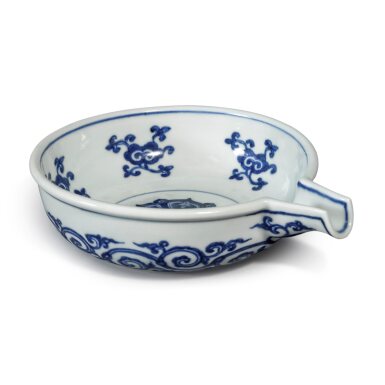
Property from the Collection of Albert Y.P. and Sara K.S. Lee
An extremely rare blue and white pouring vessel (Yi), Ming dynasty, 15th century | 明十五世紀 青花卷草紋匜
Auction Closed
September 21, 06:54 PM GMT
Estimate
60,000 - 80,000 USD
Lot Details
Description
An extremely rare blue and white pouring vessel (Yi)
Ming dynasty, 15th century
明十五世紀 青花卷草紋匜
Length across spout 8¼ in., 21 cm
C.C. Lai, Hong Kong, 1971.
C.C. Lai,香港,1971年
Finely potted, the present piece is extremely rare in terms of form and design, and only one other example appears to be recorded. See a closely related vessel of similar size in the National Palace Museum, Taipei (accession no. 故瓷012298N000000000), attributed to the 'official kilns' of the Ming dynasty.
Painted in a deep, rich cobalt, the interior is decorated with lappets enclosing a whorl, surrounded by lingzhi on the cavetto while a band of floral scrolls encircle the exterior of the vessel and extend to the underside of the spout. Compare the similarly painted floral scrolls on two blue and white bowls, attributed to the period between Zhengtong and Tianshun, excavated in 2014 and exhibited in Zhuoshuo chongxian: shiwu shiji zhongqi Jingdezhen ciqi teji / Lustre Revealed: Jingdezhen Porcelain Wares in Mid Fifteenth Century China, Shanghai Museum, Shanghai, 2019, cat. nos 136 and 138.
According to Geng Baochang in Ming Qing ciqi jianding [Appraisal of Ming and Qing porcelain], Hong Kong, 1993, p. 48, blue and white vessels of this form, known as yi, were first produced in the Yuan dynasty at the Jingdezhen kilns. See several pouring bowls of this form and decorated with various floral designs attributed to the Yuan dynasty, illustrated in Zhongguo taoci quanji, vol. 11, Shanghai, 2000, pls 213-217. For fifteenth century examples of the same yi form, but with an unglazed base, see three decorated with dragons to the exterior, each of blue and white, red or green enamel, exhibited in op. cit., cat nos 193-195.
You May Also Like










